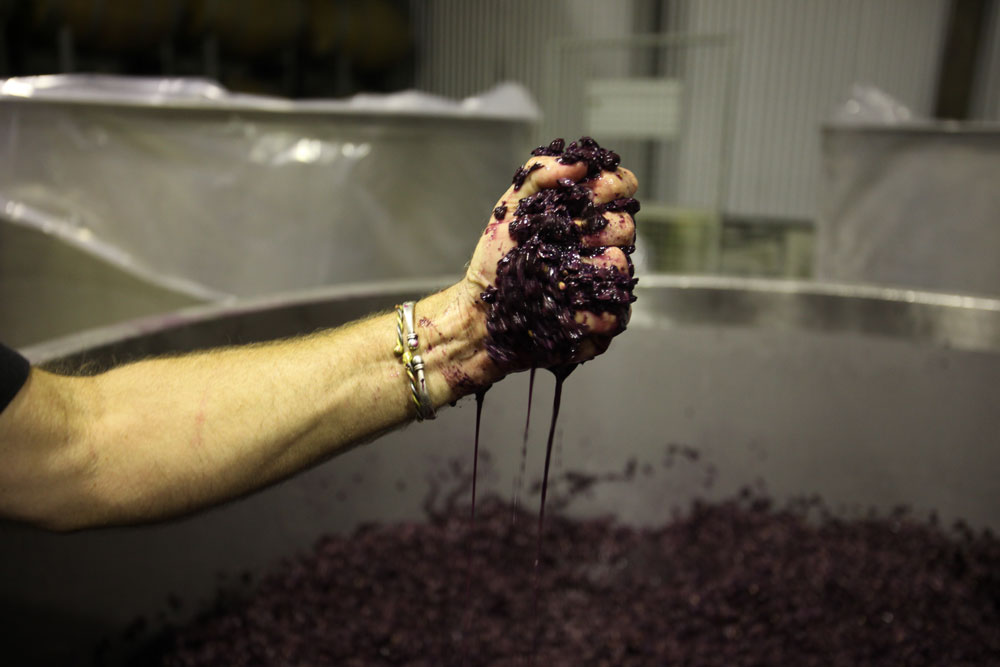This article was published in the March/April 2018 issue of the Wine & Viticulture Journal.
By Dimitra Capone, Wes Pearson, Keren Bindon, Stella Kassara, Mark Solomon, Laura Bey, Leigh Francis, Markus Herderich and Dan Johnson, The Australian Wine Research Institute, PO Box 197, Glen Osmond SA 5064, Australia
A multi-pronged approach to researching ‘green’ flavours in red wines is paying dividends for researchers and wine producers. Innovative sensory approaches have led to new understanding of what is meant by the terms ‘green’ and ‘green tannin’ in wine. Experiments looking at inclusion of stems and leaves in ferments and the influence of local vegetation on wine flavour have contributed insight into the origin of ‘green’ flavours and how winemakers may be able to manage them to achieve a desired style.
INTRODUCTION
Producing appealing and distinctive wines without sensory defects is the goal of most wine producers. Helping grapegrowers avoid sensory deficiencies has been a major role of the AWRI since its inception. One negative sensory characteristic of red wines that has been hard to manage is the ‘green’ flavour that can be seen in some red wines. Part of the challenge from a technical point of view is the vagueness of the term ‘green’ when it is applied to finished wines. The ambiguity and variation of flavour descriptors used across our industry means there is a lack of clarity regarding what is meant when describing a wine as having a ‘green’ character. For some industry personnel, ‘green’ can mean ‘grassy’ or ‘herbal’, for others it might refer to ‘green capsicum’ or ‘asparagus-like’ aroma, or ‘cooked vegetal’, or ‘lower fruit’ flavour combined with higher acidity and tannin. Still others may use the term ‘green’ to refer to a particular texture or mouthfeel of the wine, which can be labelled ‘green tannin’. For some people all of the above characteristics might be lumped into describing a wine as ‘green’, which can be used as a synonym for unripe. In addition, some winemakers might describe wines with a noticeable ‘mint’ or ‘eucalyptus’ flavour as having ‘green’ nuances. In unripe fruit, ‘green’ characters can be quite easily understood. For example, in apples, high acid, low flavour and low sweetness would be clearly linked to ‘greenness’, or for bananas, high drying astringency, firm texture and low sweetness would be the dominant sensory properties. With wine the situation is more complex. Over the last several years, the AWRI has worked on a project to better define the chemical basis of ‘green’ flavours in red wine, and to find the main causes of these characters. This aim was pursued via several different avenues.
DEFINING ‘GREEN’ WINES: RELATING WINEMAKER DESCRIPTORS, CHEMICAL COMPOSITION AND SENSORY DESCRIPTIVE ANALYSIS ATTRIBUTES
Commercially-available red wines with a range of ‘green’ characters were selected and studied extensively to achieve a detailed understanding of what winemakers mean when they use different terms to describe wines with ‘green’ characters, and to provide a link between chemical composition and sensory properties. There was also interest in shedding light on what might be meant by the term ‘green tannin’ (sometimes used by winemakers) and establishing the compounds that are related to this sensory term. Forty candidate Cabernet Sauvignon wines and 60 Shiraz wines were initially selected from a wide range of regions, based on previous experience of wines showing some ‘green’ characters. Following a series of sensory evaluation sessions, 18 wines of each variety were selected that showed a variety of different ‘green’ sensory properties, including some with no ‘green’ or unripe characters at all to act as controls. The wines were characterised using two different sensory techniques: sensory descriptive analysis and projective mapping, with the Cabernet Sauvignon wines assessed separately from the Shiraz wines. For the sensory descriptive analysis, the AWRI’s trained and highly experienced panel evaluated the wines using terms generated by the panel, which were extensively discussed and refined through multiple training sessions. The final list of ‘green’ terms chosen by the panel to describe the Cabernet Sauvignon wines were ‘green stalks’, ‘fresh herbs’, ‘eucalypt’ and ‘vegetal’ for aroma, and ‘green stalks’ and ‘mint’/‘herb’ on the palate. Palate attributes such as ‘acidity’, ‘astringency’, ‘bitterness’ and ‘viscosity’, and standard fruit-related terms were also rated. The panel evaluated the wines against these terms in triplicate. The projective mapping exercise involved a group of 20 wine professionals, with each judge producing maps of the wines in duplicate. The judges were asked to evaluate each wine, and then place it on a 60cm × 90cm sheet of paper according to their own criteria, with similar wines placed close to each other and dissimilar wines placed far apart from each other. Judges were also asked to write comments beside each wine describing the characteristics responsible for its placement. Once all the maps were completed the location data and attributes/comments were entered into a sensory software package and a group map was obtained, along with the associated attributes/comments from the judges. The judges came up with 121 unique comments to describe the wines, and 18 of those terms related to ‘green’ characteristics. For an attribute or a close synonym to be included in the data analysis, it had to have been used at least four times by the judges, which reduced the number of terms to 52. Figure 1 shows the map generated from the winemakers’ descriptions and groupings of the Cabernet Sauvignon wines. The wines to the right of the figure were considered ‘ripe’ with fuller body, ‘dense’ ‘black’ fruit characters, with the terms ‘texture’ and ‘ripe tannin’ used for these wines. Wines situated on the left of the map were described with various ‘green’ terms, with the examples to the top left of the figure indicated as being ‘leafy’, ‘herbal’, ‘asparagus’, ‘capsicum-like’, with lower ‘fruit’ or ‘red fruit’. Those to the bottom left of Figure 1 were described as ‘simple’, ‘blue fruit/fruit-driven’, ‘medium body’, and were also described with the terms ‘green’ and ‘green tannin’. The most interesting aspect of this mapping technique is the way it can be used to explore the relationships with chemical data and sensory descriptive data. All wines plotted to the left of Figure 1 were described by the AWRI panel as being higher in ‘vegetal’ and ‘green stalks’ attributes. These wines were generally higher in 2-isobutyl-3-methoxypyrazine and dimethyl sulfide, two compounds known to cause these types of flavours. The wines in the ‘green tannin’ group were distinctive as they were rated by the AWRI panel as being higher in bitterness. The inclusion of bitterness as a feature of ‘green tannin’ is a new piece of information, and it was interesting that the panel of wine professionals did not use bitterness as a specific term. Bitterness was related to the chemical features of the tannins in the ‘green tannin’ wines, notably the proportion of epicatechin or galloylation in the tannin. This observation will be confirmed in further studies, but it opens up the possibility of being able to define chemically what is responsible for undesirable ‘green tannin’ textural elements in red wines, and to assess viticultural or winemaking ways of adjusting the tannin make-up. For the Shiraz wines, a closely similar assessment procedure was followed, and there were a similar set of outcomes (Figure 2, page 36). The ‘vegetal’ attribute was more closely linked to higher DMS in these wines. The winemakers described the high DMS wines as being ‘green’ and ‘hard’ with ‘hard tannin’, but this seemed to be associated with the ‘vegetal’ and ‘stemmy’ flavour and somewhat higher acidity rather than textural aspects of the wines. From a scientific point of view, a noteworthy result was that the ‘stemmy’/‘stalky’ wines had elevated 2-isobutyl-3-methoxypyrazine, which is not usually considered a characteristic of Shiraz wines, and which was most likely related to the use of whole bunch fermentation in these wines. This observation was explored further in a subsequent study. Overall, this investigation of commercially available wines laid the foundation for more controlled studies of the causes of these ‘green’ characters in wine and ways to control them.
INCORPORATION OF STEMS AND LEAVES IN COOL CLIMATE SHIRAZ FERMENTATION
A second aspect of the ‘green’ research was an assessment of the impact of grape stems (the rachis) and grape leaves on Shiraz flavour. With the increasing use in recent years of whole bunch (incorporating the stems), or whole berry (use of intact, uncrushed berries) fermentation, exploring the effect of including stems and leaves on ‘green’ characters was of value. Shiraz fruit (2014 vintage) from a premium Adelaide Hills vineyard was harvested and winemaking was completed by WIC Winemaking Services at the Waite Campus. The project assessed the addition of stalks and leaves to ferments, but not the use of whole berries. The protocol involved carefully removing by hand all the berries from around 100kg of hand-picked grape bunches. Replicated winemaking was then performed with grape berries only; grape berries plus grape stems (both the rachis and the peduncles – the part of the stalk that joins the bunch to the vine); grape berries plus the peduncles only; and grape berries plus grapevine leaves at a level equivalent to common levels of matter other than grapes (MOG) in commercial ferments. The wines were comprehensively chemically analysed, and the sensory attributes were rated by a trained sensory descriptive analysis panel. The results of the sensory study are shown in Figure 3, page 37. The addition of grape leaves had surprisingly little effect, with no enhancement of ‘green’ attributes at all. The wine with added leaves was rated as higher in ‘confectionery’ (‘ester’) aroma and flavour, and had a higher concentration of some esters, which corresponds with the results of previous studies from CSIRO where ‘green’ compounds derived from grapes were shown to be transformed into ‘fruity’ acetate esters (Dennis et al. 2012). The inclusion of grape stems in the fermentation had a dramatic effect, enhancing colour intensity, astringency and acidity, as well as increasing ‘green stalks’, ‘green capsicum’ character, and lowering ‘confection’, ‘floral’, and ‘red fruit’ characters. The added peduncles-only treatment gave a small enhancement of ‘green’ attributes. The wine made with added stems was found to contain a relatively high concentration of 2-isobutyl-3-methoxypyrazine (consistent with the findings of the study of commercially available wines), as well as higher tannin concentration with a different composition, and higher levels of pigment compounds. In summary, this study showed that leaves in a ferment were not contributors to ‘green’ flavour, but the inclusion of stems can give rise to ‘green’ aroma characters, related to increased concentrations of methoxypyrazines.
CAN LOCAL VEGETATION CONTRIBUTE TO ‘GREEN’ FLAVOUR?
Following previous AWRI studies of eucalyptus trees near vineyards, which showed that ‘mint’ and ‘eucalypt-type’ flavours can be transferred to must (especially through inclusion of eucalypt leaves in the harvest bin), AWRI researchers have been investigating whether other trees planted near vineyards might also give ‘green’ attributes to wines. Three main vineyards were studied: a Pinot Noir vineyard in the Adelaide Hills with a radiata pine (Pinus radiata) windbreak, a Shiraz vineyard at Langhorne Creek with a windbreak row of she-oaks (Casuarina cunninghamiana), and a Cabernet Sauvignon vineyard in the Yarra Valley close to plantings of Monterey cypress (Cupressus macrocarpa). In the 2016 vintage, wines were made from grapes picked from the rows closest to the trees and from rows furthest away. An additional set of ferments was conducted with the fruit from the rows furthest from the trees plus added leaf material from the trees. Similar to the previous studies with eucalyptus trees, it was noted that some bunches on vines close to the trees clearly contained pine needles or other tree material. Chemical and sensory analysis showed that there was no clear sensory influence from the radiata pine and she-oak trees. For the wines made from the vines planted near Monterey cypress trees, a ‘herbal’/‘pinelike’ aroma and flavour was observed. The wines made from the grapes grown closest to the trees had the highest ratings from the sensory panel for ‘eucalypt’/‘pine’ aroma and flavour attributes. The wine made from grapes sampled farthest away from the trees was rated lowest in these attributes, while the addition of foliage material from the trees to these grapes resulted in intermediate ratings for these attributes in the wines. Overall, it seems some types of ‘green’ character can result from certain types of vegetation grown close to vineyards.
CONCLUSION
These interlinked investigations into ‘green’ flavour have provided valuable outcomes for Australian grapegrowers and winemakers. The most notable in some ways has been the observation that 2-isobutyl-3-methoxypyrazine can be found in important levels in Shiraz wines, a variety which was not considered previously able to produce this class of compound. It seems likely that it arises in wines from extraction from the rachis, but further work is currently being carried out with collaborators at CSIRO to confirm this. The observation of a link between ‘hard’, ‘bitter’, ‘green’ tannins and specific tannin structures is also a significant step forward. Overall, these studies involving the examination of ‘green’ aroma compounds in combination with non-volatile mouthfeel and textural compounds have great promise in finally allowing growers and winemakers to manage these characters in red wines.
ACKNOWLEDGEMENTS
This work is supported by Australia’s grapegrowers and winemakers through their investment body, Wine Australia, with matching funds from the Australian government. The AWRI is a member of the Wine Innovation Cluster in Adelaide, South Australia. The authors thank Adam Wadewitz from Shaw + Smith Wines, Behn Payten and Tim Shand from Punt Road Wines, and Jon Baldwin from Marandoo Estate, as well as the sensory panellists, WIC Winemaking Services, AWRI Commercial Services, Metabolomics Australia, Alice Barker, Joanna Vervey and the producers who donated wines. Ella Robinson is thanked for editorial assistance.
REFERENCES AND FURTHER READING
Capone, D.; Bey, L.; Barker, A.; Espinase Nandorfy, D.; Williamson, P.; Solomon, M. and Francis, L. (2017) Trees and vines: can different types of local vegetation contribute to wine flavour? AWRI Tech. Rev. August: 7-10.
Dennis, E.G.; Keyzers, R.A.; Kalua, C.M.; Maffei, S.M.; Nicholson, E.L. and Boss, P.K. (2012) Grape contribution to wine aroma: Production of hexyl acetate, octyl acetate, and benzyl acetate during yeast fermentation is dependent upon precursors in the must. J. Agric. Food Chem. 60: 2638-2646.
















